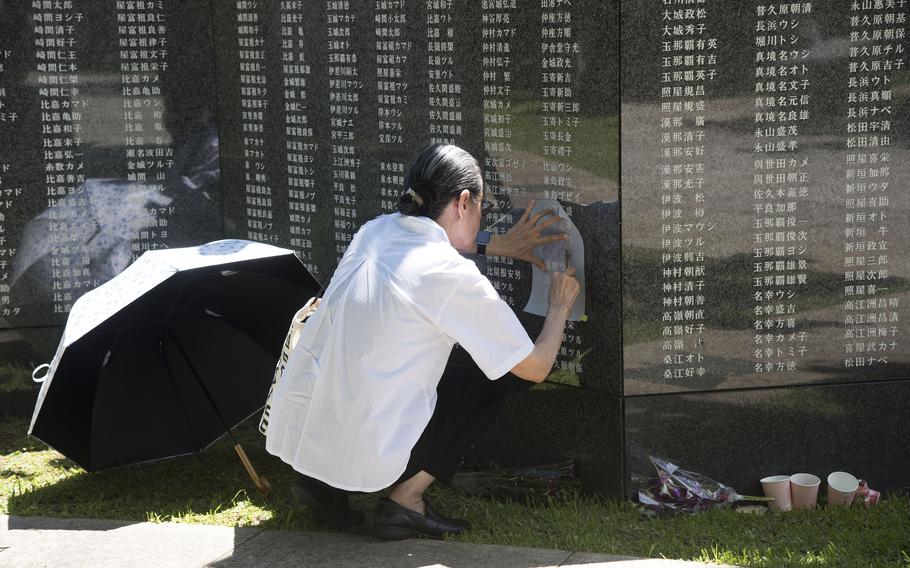
A visitor makes a rubbing of a name on the Cornerstone of Peace monument at Peace Memorial Park in Itoman, Okinawa, June 23, 2025. (Keishi Koja/Stars and Stripes)
ITOMAN, Okinawa — Thousands filled Peace Memorial Park on Monday to mark the 80th anniversary of the end of the Battle of Okinawa, as U.S. and Japanese officials delivered messages of peace in separate ceremonies.
More than 4,000 people endured scorching sun and high humidity for Irei No Hi — Okinawa’s memorial day — marking the end of one of World War II’s bloodiest fights. More than 240,000 — their names inscribed on the park’s Cornerstone of Peace monument — died during or after the battle.
Attendees dressed in black lit incense and laid flowers and food offerings by the names of their loved ones on the memorial.
Soichi Yamaniha, 91, was 11 during the battle, he told Stars and Stripes. His father, Junkichi Yamaniha, was the director of Kirabaru district, in charge of providing food to imperial soldiers. Both his parents survived the war, he said.
“I like how peaceful it is right now,” he said. “During the war, I couldn’t do anything on my own. I had to follow orders.”
Okinawa Gov. Denny Tamaki in remarks during the ceremony asked the audience to remember the lessons from the battle and think of how to “break down the absurd current situation and bring lasting peace to the world.”
He mentioned the “heavy burden” of U.S. military bases on Okinawa and protested the ongoing construction of the new Marine Corps airfield on Camp Schwab to replace Marine Corps Air Station Futenma.
“It is possible to suspend operations at Futenma without relocating it to Henoko,” he told reporters during a news conference inside the museum following the ceremony, calling it a “false solution.” He called on the Japanese and U.S. governments to work together to come up with alternatives.
Prime Minister Shigeru Ishiba, in his first Irei No Hi address, asked the crowd to reflect on “the stupidity and tragedy of war.” He also said he is determined to reduce Okinawa’s U.S. military burden “in a visible way.”
As he said this, a protester began shouting: “Don’t turn Okinawa into a battlefield!” He was quickly dragged away by event security to scattered applause.
Earlier that day, Lt. Gen. Roger Turner, commander of the III Marine Expeditionary Force, urged about 50 Marines gathered in front of the American section of the Cornerstone of Peace to remember “the sacrifices on all sides.”
He also praised the U.S.-Japan alliance for maintaining peace in the Indo-Pacific region for eight decades.
“We now have potential adversaries who seek to disrupt that and who seek to change the status quo of peace that is here,” he said. “It’s incredibly important that the U.S.-Japan alliance see through that and be reinforced and continue to grow.”
Michael Hopkins, 76, of Garden City, N.Y., attended the U.S. ceremony with his sister, Olga Hopkins-Murray, 63. They had been planning the trip for more than five years to honor their father, Marine 1st Lt. Joseph Hopkins, who fought in and survived the battle, he told Stars and Stripes.
“We’ve been dreaming about it,” he said. “This is the only way I can figure of getting all this stuff out of my mind that’s been nagging me for the years that I’ve known about this.”